Tree-grass competition in Savannas
We currently have two separate projects investigating how trees and grasses coexist and compete for water in lowveld savanna. Savannas are defined by this coexistence, and yet we as a community are still investigating the role of top-down and bottom-up drivers of savanna ecology. The links below will provide more details on each.
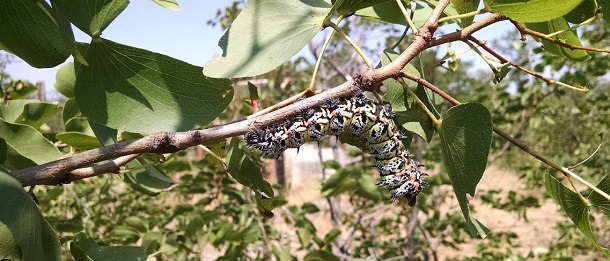
One of the primary tree species of our savannas is Mopane. The classic tropical mono-dominant tree.
Rainfall Manipulation Experiment at WRF
The major goals of this project are to understand why woody plant abundance and productivity tends to increase as a function of mean annual rainfall in tropical savannas, and to develop predictive models of tree cover change under novel rainfall regimes. The research has three specific objectives: (1) to identify the rainfall variables that promote trees over grasses, (2) to identify the functional traits and tradeoffs axes that differentiate savanna trees and grasses, and (3) to develop and test a mechanistic model of tree:grass dynamics as a function of rainfall. We are working at Wits Rural Facility field station in South Africa. We establshed the experimental site in March 2017 and planted trees in 2018 and 2019. Completion of the experimental setup occured in Fall 2020.
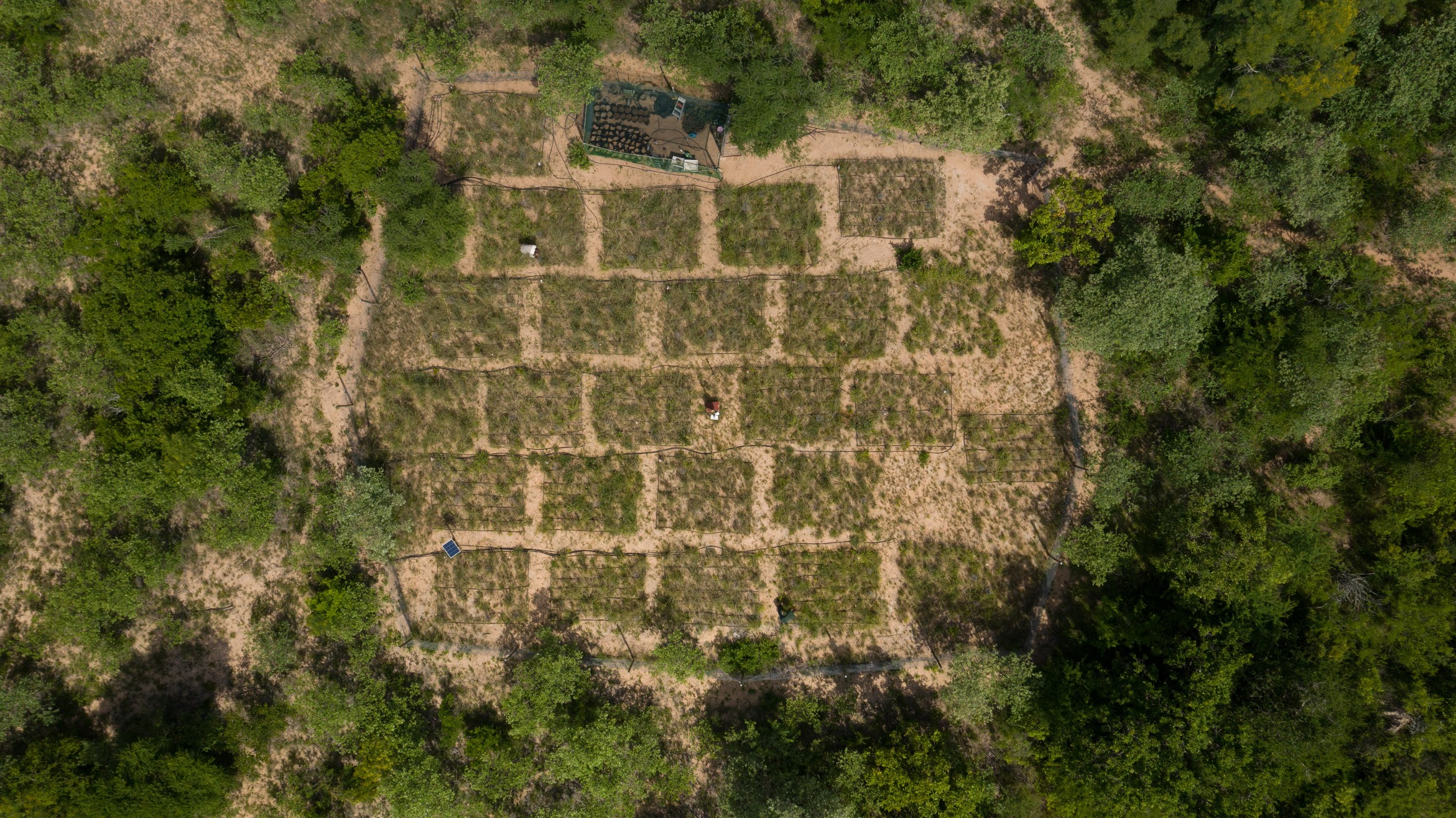
Aerial view of our WRF experiment, showing the 25 plots of rainfall manipulations. Photo by Wayne Twine (Dec. 2020).
Underpinning the three objectives is a common set of competing hypotheses to explain the relationship between mean annual rainfall (MAR) and tree cover: the rooting depth hypothesis proposes that increases in MAR lead to deeper infiltration, favoring deeper-rooted trees over grasses. The intensity hypothesis proposes that the relative advantage of grasses conferred by their ability to exploit large water pulses diminishes as MAR increases. The phenology hypothesis proposes that the positive correlation between MAR and the length of the growing season favors trees due to tree-grass phenological differences. The grass dominance hypothesis suggests that grasses always outperform trees when competing for water, therefore consistently benefiting from additional water, regardless of how it is distributed.
The core of the project is a rainfall manipulation experiment consisting of five rainfall treatments applied across a set of 12-m2 plots (5 replicates per treatment, N = 25 plots) within a cleared area in the WRF study site. The plots, irrigation system, fencing, weather station and necessary soil moisture sensors had been established prior to the initiation of the grant. In Feb-Mar 2020, all seedlings were tagged and measured (basal diameter and height), initial plot-level grass biomass was recorded using a disc-pasture meter, and six randomly selected grass tussocks per plot were tagged, cut at ground level, dried and weighed. This will allow both aggregate and individually tracked measurements of grass growth over the course of the experiment.
Project supported by NSF-DEB:
Collaborative Research: Rainfall variability and the axes of tree-grass niche differentiation
Project PI's:
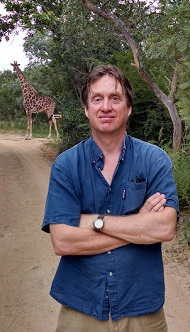
Dr. Ricardo Holdo (University of Georgia)
Dr. Jesse Nippert (Kansas State University)
Project Graduate Students:
Michael Belovitch (University of Georgia)
Emily Wedel (Kansas State University)
This project has also received tremendous support from Dr. Wayne Twine (at WRF), as well as field experiment supervision from Mr. Justice Ndhala and Mr. Craddock Mthabini. Logistical field support has been provided primarily by Jules NeSmith (Florida) and by Rachel Keen (KSU) and Caitlin Broderick (KSU).
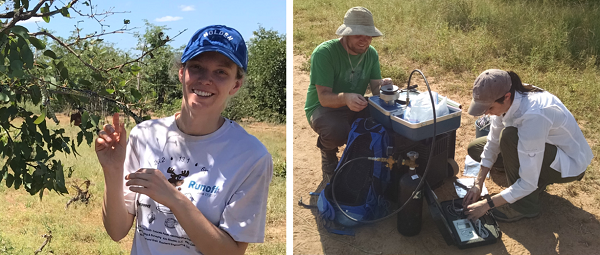
Left: Emily collecting mopane worms. Right: Michael and Rachel taking mid-days.
Mopane cutting experiment at Mthimkulu
Savannas are characterized by coexistence of trees and grasses, and their interactions are modified by both water availability and herbivore activity. Many savannas are experiencing bush encroachment, resulting in reduced herbaceous productivity and shifts in savanna structure. This study aims to understand the effects of tree density and tree cutting on herbaceous productivity, water use, and herbivore abundance in a mopane-dominated lowveld savanna.
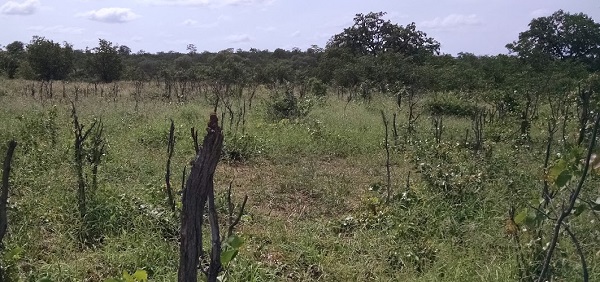
The savanna landscape with cut and resprouting mopane trees within a plot.
We have been working since 2015 at a mopane-cutting experiment in the Mthimkhulu Game Reserve bordering Kruger National Park (South Africa). We established three 60x60 m plots for experimental manipulation where mopane stems and re-sprouting shoots were cut 2-3 times per year. We used transects within the plots to measure grass productivity and herbivore activity (counts of tracks and dung). Additionally, we measured root non-structural carbohydrates within cut and uncut mopane to assess the impact of cutting on energy storage. We used stable isotopes of xylem and soil water at multiple depths to infer changes in functional water use of coexisting mopane and grass species.
Cutting had limited effects on mopane survival during this 5-year period, but re-sprouting stems had reduced height and starch concentrations than uncut trees. Cutting mopane resulted in shallower-soil water use and tended to increase variability in root water uptake across multiple soil depths. To date, the cut treatment tended to have higher grass cover and productivity than the control treatment by the 3rd growing season. Visitation of grazers increased in the cut plots relative to uncut plots by 2017, suggesting increased grass cover promotes grazer visitation.
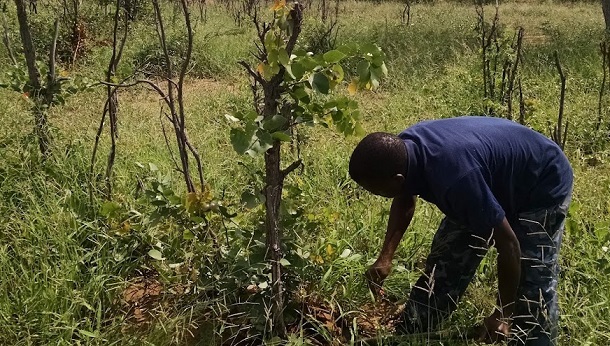
This project has been maintained by regular cutting and maintenace by Peace Nkuna and others from the Working for Water program
These results emphasize the importance of top-down drivers on savanna tree cover and the impacts of bush encroachment on grass biomass and herbivore presence. We suggest repeated cutting or browsing pressure is needed to suppress woody cover and increase grass production in lowveld savannas.
Project supported by the NRF-funded agency SAEON (South African Environment Observation Network)
Project PI's:

Dr. Tony Swemmer (SAEON Ndlovu Node)
Dr. Jesse Nippert (Kansas State University)
Project Graduate Students:
Emily Wedel (Kansas State University)